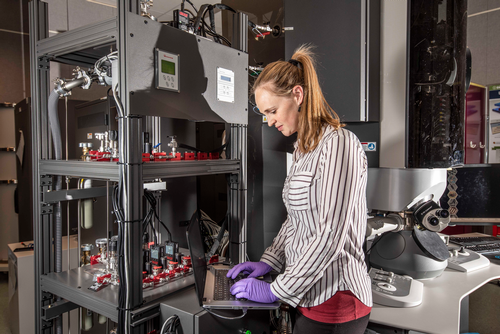THURSDAY, JULY 25, 2019
Researchers from the Department of Energy’s Center for Integrated Nanotechnologies, Sandia National Laboratories and Aramco Research Center recently discovered that a form of nanoscale corrosion can be directly responsible for the unpredictable decrease in the functionality of steel pipes.
The information derives from the paper “Localized Corrosion of Low-Carbon Steel at the Nanoscale,” which was recently published in Nature’s Materials Degradation journal.
The Research
Different from uniform corrosion, which typically occurs in bulk form, localized corrosion is invisible and creates a path that can only be viewed once its reached its endpoint, having increased bulk corrosion rates and making it easier for the corrosion to spread.

 |
| Sandia National Laboratories |
|
Researchers from the Department of Energy’s Center for Integrated Nanotechnologies, Sandia National Laboratories and Aramco Research Center recently discovered that a form of nanoscale corrosion can be directly responsible for the unpredictable decrease in the functionality of steel pipes. |
According to the press release, by taking pictures of various steel pipes with transmission electron microscopes, researchers were able to attribute the cause of the problem to a triple junction created from a grain of cementite—a compound of carbon and iron—and two grains of a type of iron called ferrite. The junction is commonly caused by most methods of fashioning steel pipe.
Due to the interfacial disorder in the atomic structure of the triple junctions, corrosive solutions could more easily remove iron atoms along the interface. During the experiment, when the triple junction was consumed by corrosion, the corrosive process came to a halt. However, the resulting crevice allowed for the corrosive solution to attack the interior of the steel.
“We thought of a possible solution for forming new pipe, based on changing the microstructure of the steel surface during forging, but it still needs to be tested and have a patent filed if it works,” said Sandia’s principle investigator Katherine Jungjohann, who is also a paper author and lead microscopist.
Aramco senior research scientist Steven Hayden added, “This was the world’s first real-time observation of nanoscale corrosion in a real-world material—carbon steel—which is the most prevalent type of steel used in infrastructure worldwide. Through it, we identified the types of interfaces and mechanisms that play a role in the initiation and progression of localized steel corrosion. The work is already being translated into models used to prevent corrosion-related catastrophes like infrastructure collapse and pipeline breaks.”
In order to mimic the chemical exposure pipes would normally experience in the field, very thin pipe samples were exposed to a variety of chemicals under a microscope. Following the exposure, paper author and researcher Khalid Hattar placed a dry sample into a vacuum and while using a transmission electron microscope, created six nanometer resolution maps of the steel grain types and their orientation.
“By comparing these maps before and after the liquid corrosion experiments, a direct identification of the first phase that fell out of the samples could be identified, essentially identifying the weakest link in the internal microstructure,” Hattar said.
Paul Kotula, another paper author and researcher at Sandia, went on to explain that samples analyzed were low-carbon steel, but relatively high-carbon inclusions of cementite were often the sites of localized corrosion.
Hayden concluded, “Now we are optimistic that further work at Sandia and the Center for Integrated Nanotechnologies will allow us to rethink manufacturing processes to minimize the expression of the susceptible nanostructures that render the steel vulnerable to accelerated decay mechanisms.”
Work for the research was funded in part by Sandia’s Laboratory Directed Research and Development program. The Center for Integrated Nanotechnologies is a DOE Office of Science user facility operated by Sandia and Los Alamos national laboratories for university, industry and other national lab researchers.
Tagged categories: Corrosion; Laboratory testing; Pipelines; Pipes; Quality Control; Research; Research and development; Steel; U.S. Department of Energy